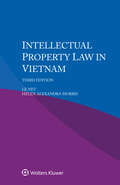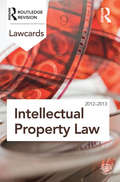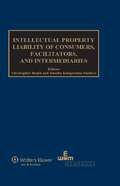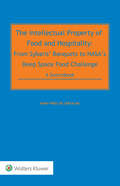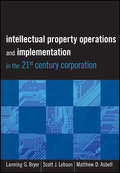- Table View
- List View
Intellectual Property Law in Switzerland
by François DessemontetDerived from the renowned multi-volume International Encyclopaedia of Laws, this monograph provides a survey and analysis of the rules concerning intellectual property rights in Switzerland. It covers every type of intellectual property right in depth – copyright and neighbouring rights, patents, utility models, trademarks, trade names, industrial designs, plant variety protection, chip protection, trade secrets, and confidential information. Particular attention is paid throughout to recent developments and trends. The analysis approaches each right in terms of its sources in law and in legislation, and proceeds to such legal issues as subject matter of protection, conditions of protection, ownership, transfer of rights, licences, scope of exclusive rights, limitations, exemptions, duration of protection, infringement, available remedies, and overlapping with other intellectual property rights. The book provides a clear overview of intellectual property legislation and policy, and at the same time offers practical guidance on which sound preliminary decisions may be based. Lawyers representing parties with interests in Switzerland will welcome this very useful guide, and academics and researchers will appreciate its value in the study of comparative intellectual property law.
Intellectual Property Law in Tanzania
by Jacob Jaconiah<span style="mso-fareast-font-family:Times-Roman;mso-bidi-font-family: Times-Roman;color:black;mso-ansi-language:EN-GB">Derived from the renowned multi-volume <span style="mso-fareast-font-family:Times-Roman;mso-bidi-font-family: Times-Roman;color:black;mso-ansi-language:EN-GB">International Encyclopaedia of Law<span style="mso-fareast-font-family:Times-Roman;mso-bidi-font-family: Times-Roman;color:black;mso-ansi-language:EN-GB">s, this monograph provides a survey and analysis of the rules concerning intellectual property rights in Tanzania. It covers every type of intellectual property right in depth – copyright and neighbouring rights, patents, utility models, trademarks, trade names, industrial designs, plant variety protection, chip protection, trade secrets, and confidential information. Particular attention is paid throughout to recent developments and trends. <span style="mso-fareast-font-family:Times-Roman;mso-bidi-font-family: Times-Roman;color:black;mso-ansi-language:EN-GB"> <span style="mso-fareast-font-family:Times-Roman;mso-bidi-font-family: Times-Roman;color:black;mso-ansi-language:EN-GB">The analysis approaches each right in terms of its sources in law and in legislation, and proceeds to such legal issues as subject matter of protection, conditions of protection, ownership, transfer of rights, licences, scope of exclusive rights, limitations, exemptions, duration of protection, infringement, available remedies, and overlapping with other intellectual property rights. <span style="mso-fareast-font-family:Times-Roman;mso-bidi-font-family: Times-Roman;color:black;mso-ansi-language:EN-GB"> <span style="mso-fareast-font-family:Times-Roman;mso-bidi-font-family: Times-Roman;color:black;mso-ansi-language:EN-GB">The book provides a clear overview of intellectual property legislation and policy, and at the same time offers practical guidance on which sound preliminary decisions may be based. Lawyers representing parties with interests in Tanzania will welcome this very useful guide, and academics and researchers will appreciate its value in the study of comparative intellectual property law.
Intellectual Property Law in the Czech Republic
by Aleš RozehnalDerived from the renowned multi-volume International Encyclopaedia of Laws, this monograph provides a survey and analysis of the rules concerning intellectual property rights in the Czech Republic. It covers every type of intellectual property right in depth – copyright and neighbouring rights, patents, utility models, trademarks, trade names, industrial designs, plant variety protection, chip protection, trade secrets, and confidential information. Particular attention is paid throughout to recent developments and trends. The analysis approaches each right in terms of its sources in law and in legislation, and proceeds to such legal issues as subject matter of protection, conditions of protection, ownership, transfer of rights, licences, scope of exclusive rights, limitations, exemptions, duration of protection, infringement, available remedies, and overlapping with other intellectual property rights. The book provides a clear overview of intellectual property legislation and policy, and at the same time offers practical guidance on which sound preliminary decisions may be based. Lawyers representing parties with interests in the Czech Republic will welcome this very useful guide, and academics and researchers will appreciate its value in the study of comparative intellectual property law.
Intellectual Property Law in the Sports and Entertainment Industries
by Walter T. Champion Kirk D. WillisIn this detailed yet readable legal analysis, the authors thoroughly evaluate the connections between intellectual property and the sports and entertainment industries, covering everything from copyrights and patents to trademarked logos and marketing strategies.This complete survey of intellectual property law in the sports and entertainment industries evaluates the key connections between these arenas and provides an overview of trademark law for sports. The authors clearly explain the rights of publicity and privacy for entertainers and athletes, the ethical considerations involved in obtaining and using intellectual property, and how licensing agreements relate to intellectual property law. The detailed, up-to-date legal analyses are written by practitioners in the field for those without legal expertise, yet still contain useful information to the legal community. The book covers all forms of intellectual property, including copyright, patents, trademarks, trade dress, trade secrets, and the right of publicity. It will also discuss marketing, broadcasting, films and books, sports equipment, international considerations and trade issues, and intellectual property in cyberspace.
Intellectual Property Law in the Sports and Entertainment Industries
by Walter T. Champion Kirk D. WillisIn this detailed yet readable legal analysis, the authors thoroughly evaluate the connections between intellectual property and the sports and entertainment industries, covering everything from copyrights and patents to trademarked logos and marketing strategies.This complete survey of intellectual property law in the sports and entertainment industries evaluates the key connections between these arenas and provides an overview of trademark law for sports. The authors clearly explain the rights of publicity and privacy for entertainers and athletes, the ethical considerations involved in obtaining and using intellectual property, and how licensing agreements relate to intellectual property law. The detailed, up-to-date legal analyses are written by practitioners in the field for those without legal expertise, yet still contain useful information to the legal community. The book covers all forms of intellectual property, including copyright, patents, trademarks, trade dress, trade secrets, and the right of publicity. It will also discuss marketing, broadcasting, films and books, sports equipment, international considerations and trade issues, and intellectual property in cyberspace.
Intellectual Property Law in Turkey
by Ergun Özsunay Murat R. ÖzsunayDerived from the renowned multi-volume International Encyclopaedia of Laws, this monograph provides a survey and analysis of the rules concerning intellectual property rights in Turkey. It covers every type of intellectual property right in depth – copyright and neighbouring rights, patents, utility models, trademarks, trade names, industrial designs, plant variety protection, chip protection, trade secrets, and confidential information. Particular attention is paid throughout to recent developments and trends. The analysis approaches each right in terms of its sources in law and in legislation, and proceeds to such legal issues as subject matter of protection, conditions of protection, ownership, transfer of rights, licences, scope of exclusive rights, limitations, exemptions, duration of protection, infringement, available remedies, and overlapping with other intellectual property rights. The book provides a clear overview of intellectual property legislation and policy, and at the same time offers practical guidance on which sound preliminary decisions may be based. Lawyers representing parties with interests in Turkey will welcome this very useful guide, and academics and researchers will appreciate its value in the study of comparative intellectual property law.
Intellectual Property Law in Vietnam
by Le Net Helen Alexandra MorrisDerived from the renowned multi-volume International Encyclopaedia of Laws, this monograph provides a survey and analysis of the rules concerning intellectual property rights in Vietnam. It covers every type of intellectual property right in depth – copyright and neighbouring rights, patents, utility models, trademarks, trade names, industrial designs, plant variety protection, chip protection, trade secrets, and confidential information. Particular attention is paid throughout to recent developments and trends. The analysis approaches each right in terms of its sources in law and in legislation, and proceeds to such legal issues as subject matter of protection, conditions of protection, ownership, transfer of rights, licences, scope of exclusive rights, limitations, exemptions, duration of protection, infringement, available remedies, and overlapping with other intellectual property rights. The book provides a clear overview of intellectual property legislation and policy, and at the same time offers practical guidance on which sound preliminary decisions may be based. Lawyers representing parties with interests in Vietnam will welcome this very useful guide, and academics and researchers will appreciate its value in the study of comparative intellectual property law.
Intellectual Property Law of Plants
by Mark D. Janis Herbert H. Jervis Richard C. PeetPlant intellectual property law is a complex proposition which stands apart from other intellectual property endeavours, and this book seeks to elucidate on the key issues involved. This work encompasses aspects of plant innovation and related law in the US and overseas providing a global perspective. Full treatment is given to the legal and technological framework; intellectual property regimes of importance in plant breeding; formal grants of rights under plant variety protection schemes; plant and utility patent regimes and trade mark regimes. Antitrust restrictions on intellectual property licensing and international regulations on plant genetic resources are also covered in detail. All this ensures this text guarantees a comprehensive collection of all useful materials. Written by an expert team of both academics and practitioners, this book is the first to provide unique practical analysis on the creation and implementation of specialised, plant-specific intellectual property regimes.
Intellectual Property Law: Text, Cases, And Materials (Text,cases And Materials Ser.)
by Tanya Aplin Jennifer DavisThis book combines extracts from major cases and secondary materials with critical commentary to provide a complete resource for undergraduate and postgraduate students of intellectual property law. All areas of intellectual property law in the UK are covered: copyright, trade marks and passing off, confidential information, industrial designs, patent, procedure and enforcement. This book also tackles topical areas, such as the application of intellectual property law to new technologies and character merchandising. While the focus of the book is on intellectual property law in a domestic context, it provides international, EU and comparative law perspectives on major issues. It also addresses the wider policy implications of legislative and judicial developments in the area.
Intellectual Property Law (PDF)
by Lionel Bently Brad Sherman Dev Gangjee Phillip JohnsonIntellectual Property Law is the definitive textbook on the subject. The authors' all-embracing approach not only clearly sets out the law in relation to copyright, patents, trade marks, passing off, and confidentiality, but also takes account of a wide range of academic opinion enabling readers to explore and make informed judgements about key principles. The particularly clear and lively writing style ensures that even the most complex areas are lucid and comprehensible.
Intellectual Property Law (PDF)
by Tina Hart Simon Clark Linda FazzaniThe Palgrave Law Masters series is a long-established list of titles providing clear, concise and authoritative guides to the main subject areas, written by experienced and respected authors. This sixth edition of Intellectual Property Law has been thoroughly updated to reflect the recent developments in this intricate and technical area of commercial law. All key aspects of the topic are covered, including copyright, designs, patents, trade marks, passing off and breach of confidence. With backgrounds in both academic teaching and top legal practice, the author team combines to produce a work which is both intellectually stimulating and highly practical. The new edition includes a new expanded section on privacy. The book is an ideal course companion for undergraduates and postgraduates on law and business-related courses. It is also a useful reference for company secretaries, in-house lawyers and contracts managers.
Intellectual Property Lawcards 2012-2013 (Lawcards)
by RoutledgeRoutledge Lawcards are your complete, pocket-sized guides to key examinable areas of the undergraduate law curriculum and the CPE/GDL. Their concise text, user-friendly layout and compact format make them an ideal revision aid. Helping you to identify, understand and commit to memory the salient points of each area of the law, shouldn’t you make Routledge Lawcards your essential revision companions? Fully updated and revised with all the most important recent legal developments, Routledge Lawcards are packed with features: Revision checklists help you to consolidate the key issues within each topic Colour coded highlighting really makes cases and legislation stand out Full tables of cases and legislation make for easy reference Boxed case notes pick out the cases that are most likely to come up in exams Diagrams and flowcharts clarify and condense complex and important topics '...an excellent starting point for any enthusiastic reviser. The books are concise and get right down to the nitty-gritty of each topic.' - Lex Magazine Routledge Lawcards are supported by a Companion Website offering: Flashcard glossaries allowing you to test your understanding of key terms and definitions Multiple Choice Questions to test and consolidate your revision of each chapter Advice and tips to help you better plan your revision and prepare for your exams Titles in the Series: Commercial Law; Company Law; Constitutional Law; Contract Law; Criminal Law; Employment Law; English Legal System; European Union Law; Evidence; Equity and Trusts; Family Law; Human Rights; Intellectual Property Law; Jurisprudence; Land Law; Tort Law
Intellectual Property Lawcards 2012-2013 (Lawcards)
by RoutledgeRoutledge Lawcards are your complete, pocket-sized guides to key examinable areas of the undergraduate law curriculum and the CPE/GDL. Their concise text, user-friendly layout and compact format make them an ideal revision aid. Helping you to identify, understand and commit to memory the salient points of each area of the law, shouldn’t you make Routledge Lawcards your essential revision companions? Fully updated and revised with all the most important recent legal developments, Routledge Lawcards are packed with features: Revision checklists help you to consolidate the key issues within each topic Colour coded highlighting really makes cases and legislation stand out Full tables of cases and legislation make for easy reference Boxed case notes pick out the cases that are most likely to come up in exams Diagrams and flowcharts clarify and condense complex and important topics '...an excellent starting point for any enthusiastic reviser. The books are concise and get right down to the nitty-gritty of each topic.' - Lex Magazine Routledge Lawcards are supported by a Companion Website offering: Flashcard glossaries allowing you to test your understanding of key terms and definitions Multiple Choice Questions to test and consolidate your revision of each chapter Advice and tips to help you better plan your revision and prepare for your exams Titles in the Series: Commercial Law; Company Law; Constitutional Law; Contract Law; Criminal Law; Employment Law; English Legal System; European Union Law; Evidence; Equity and Trusts; Family Law; Human Rights; Intellectual Property Law; Jurisprudence; Land Law; Tort Law
Intellectual Property Liability of Consumers, Facilitators and Intermediaries
by Christopher Heath Anselm Kamperman SandersWith reports from all major jurisdictions where the responsibility of facilitators and intermediaries for copyright and trade mark infringement have been litigated, this very useful book is the first comprehensive global survey of the liability regime that intermediaries may face when assisting others to directly infringe copyright and trade mark rights, or when providing others with the means to do so. It addresses such issues as the following: ISP liability; contributory and secondary liability for trade mark, copyright, and patent infringement; time- and geo-shifting devices and services; consumer identification through dynamic IP addresses; infringements committed on a “commercial scale”; liability of hosting providers; requirements for a breach of duty of care; notice to users to refrain from infringements; filters and other due diligence measures; “actual knowledge”; privacy and infringers’ personal data; file sharing services; online storage services; and liability of transporters and freighters. After a general introduction analysing relevant aspects of trade mark and copyright law, local experts provide detailed reports on positions in the EU (at the Community level), Germany, France, Italy, The United States, Japan, Korea, Australia, and New Zealand. As well as dealing with the issues, each report pays close attention to case law, legislative developments, and procedural issues of injunctive relief and damages. A final chapter covers comparative contributory patent infringement. Along with the very practical value the book offers corporate counsel charged with IP rights litigation, the authors shed light on the fundamental issue of whether attempts to broaden liability in this area are compatible with established IP principles such as territoriality, freedom to operate, and freedom of competition. As a result, the book will be welcomed by a wide spectrum of lawyers and others working in this rapidly growing field, including practitioners, policymakers, academics, and jurists.
Intellectual Property Management: Interdisciplinary Knowledge for Business Decision-Making
by Irina HeimAn understanding of intellectual property is an essential component of management and business strategy in many industries. It can be used to generate value and create competitive advantage and goes hand-in-hand with the study of technology innovation and international business. However, the literature on intellectual property has been dominated by writers with backgrounds in legal science and economics. This book advocates an interdisciplinary view on intellectual property management for business and management students and professionals. It provides an outline of the field in terms that are tailored to management scholarship and with an emphasis on business decision making. It is intended for business school students of intellectual property management, innovation, strategic management and industry studies, as well as professionals in need of an accessible and business-minded approach to intellectual property management.
Intellectual Property Management: A Guide for Scientists, Engineers, Financiers, and Managers
by Claas Junghans Adam LevyThis concise introduction to European patent law and global patent perspectives combines the legal and economic perspectives to adopt a unique approach that serves both inventors -- engineers and scientists -- as well as financiers and economists. Written by experts with first-hand knowledge this book is completely up-to-date, taking into account recent additions to European patent law, especially in the field of biotechnology and genetics. While concentrating on the EU, the world perspective is nevertheless represented, including US particularities. The result is a set of guidelines allowing readers to develop a holistic patent strategy suitable for their specific needs. For scientists, engineers, managers and financiers in the chemical industry.
Intellectual Property Management: A Guide for Scientists, Engineers, Financiers, and Managers
by Claas Junghans Adam LevyThis concise introduction to European patent law and global patent perspectives combines the legal and economic perspectives to adopt a unique approach that serves both inventors -- engineers and scientists -- as well as financiers and economists. Written by experts with first-hand knowledge this book is completely up-to-date, taking into account recent additions to European patent law, especially in the field of biotechnology and genetics. While concentrating on the EU, the world perspective is nevertheless represented, including US particularities. The result is a set of guidelines allowing readers to develop a holistic patent strategy suitable for their specific needs. For scientists, engineers, managers and financiers in the chemical industry.
Intellectual Property Management: Geistiges Eigentum als Führungsinstrument und Erfolgsfaktor in der Wissensökonomie
by Axel MittelstaedtDie Grundlagen des Intellectual Property Managements und seine konkrete Umsetzung in Unternehmen werden in diesem Buch praxisnah und verständlich für Nicht-Juristen erklärt. Der Schutz von immateriellen Unternehmensgütern wie Marken, Patenten oder Design wird zunehmend zum Wirtschafts- und Wachstumsfaktor und bietet beträchtliches Erfolgspotenzial. Deshalb gewinnt dieses Thema für das Management immer mehr an Bedeutung. Der Autor analysiert an konkreten Beispielen, wie IP generiert, identifiziert, dokumentiert, mit den gesetzlich dafür vorgesehenen Möglichkeiten geschützt und für den Unternehmenserfolg genutzt werden kann. Beleuchtet werden insbesondere Management- und Strategie-Aspekte im Zusammenhang mit rechtlichen Fragestellungen und ihre Bedeutung für den Unternehmenserfolg. Das Buch bietet Orientierung, sensibilisiert für Fallstricke und liefert Ansätze für Schutzrechtsstrategien.
Intellectual Property Management in R&D Collaborations: The Case of the Service Industry Sector (Contributions to Management Science)
by Martin A. BaderThis work examines the current, relevant and complex problem of how companies can take an intellectual property lead within research and development collaborations. Special emphasis is placed on the early phases of the innovation process and the service industry sector in which intellectual property management is still a new phenomenon. The author derives archetypes for managing intellectual property in collaborations and analyses their strengths and weaknesses.
Intellectual Property, Medicine and Health
by Johanna GibsonIntellectual Property, Medicine and Health examines critical issues and debates, including access to knowledge and medicinal products, human rights and development, innovations in life technologies and the possibility for ethical frameworks for intellectual property law and its application in public health. The second edition accounts for recent and in some areas extensive developments in this dynamic and fast-moving field. This edition brings together new and updated examples and analysis in competition and regulation, gene-related inventions and biotechnology, as well as significant cases, including Novartis v Union of India.
Intellectual Property, Medicine and Health: Current Debates (Intellectual Property, Theory, Culture Ser.)
by Johanna GibsonIntellectual Property, Medicine and Health examines critical issues and debates, including access to knowledge and medicinal products, human rights and development, innovations in life technologies and the possibility for ethical frameworks for intellectual property law and its application in public health. The second edition accounts for recent and in some areas extensive developments in this dynamic and fast-moving field. This edition brings together new and updated examples and analysis in competition and regulation, gene-related inventions and biotechnology, as well as significant cases, including Novartis v Union of India.
Intellectual Property Objectives in International Investment Agreements (Elgar Intellectual Property and Global Development series)
by Pratyush Nath UpretiThis timely book reconciles the competing objectives of intellectual property and international investment agreements. Throughout, Pratyush Nath Upreti examines the issues arising from recent intellectual property disputes in investment arbitration from the perspectives of national and international legal orders, providing a normative analysis to resolve the tension brought by intellectual property and investor-state dispute settlement interactions.The analysis that the book offers is not confined to the intellectual property regime; it takes a pragmatic approach in terms of substantial analysis by also exploring the international trade regime, investment law and arbitration to address the key challenges to intellectual property and investor-state dispute settlement interaction. The author also considers the emerging and potential transformation of international intellectual property law, putting more emphasis on the need to shelter its intrinsic value.This thought-provoking book will be a key point of reference for law scholars, practitioners, and students in both developing and developed countries who are interested in intellectual property, investment law, and arbitration. It is also an essential read for policy makers, government officers, and lawyers involved with trade and Investment agreement negotiations.
The Intellectual Property of Food and Hospitality: A Sourcebook
by Nuno Pires de CarvalhoNuno Pires de Carvalho, widely honored for his incomparable research in the origins and development of intellectual property, has devoted a considerable portion of his writing to the role this field of law plays in specific areas of human endeavor, including medicine and fashion. In this book, he brings his meticulous scholarship to bear on how society has constructed intellectual property so as to adapt it to the needs of the industries of food and hospitality and how entrepreneurs have extracted from intellectual property the most appropriate means for capturing knowledge and reputation in these two fields of business. Presenting a comprehensive collection of more than two hundred documentary sources illustrating this evolution since antiquity ¬– with notes explaining the context and relevance of each source – the book delineates the enchainment of important moments in the development of intellectual property in the context of food and hospitality. Along the way, the book details the particular development of such specific aspects as the following: rules against unfair competition among food producers and preparers; patents for culinary recipes, foodstuffs, and hospitality services; exclusions from patentability; marking of goods and containers; inventions of devices and processes in food preparation; identifiers in such industries as cutlery, baking, winemaking, cheesemaking, and brewing; emergence of intellectual property for plant varieties; database protection for organized compilations of recipes. To illustrate some of the peculiarities of intellectual property as applied to food and hospitality, the book includes numerous pictures of patent and copyright claim documents, trademarks, advertisements, labels, culinary book covers, and food preparation devices. Because of the multiple nature of the human activities behind it, food calls for every variant of intellectual property. Thus, this matchless volume will be of great interest to all concerned with any branch of intellectual property law, including practitioners, academics, magistrates, government officials, and even the legal community as a whole. The book will reveal not only the ways intellectual property evolves and adapts to social changes but also how intellectual property law accommodates the needs and aspirations of entrepreneurs in the fields of food and hospitality.
The Intellectual Property of Textiles and Fashion: A Sourcebook
by Nuno Pires de CarvalhoRampant global counterfeiting has led the fashion industry to seek ever greater enforcement of its intellectual property (IP) rights. Yet, as this hugely informative book shows, this is not new. Fashion designers and entrepreneurs, as well as manufacturers and tradespeople in the broader textiles industry from which fashion springs, have always struggled to convert existing IP rules to an industry that was—and is—configured by the pressure of intrinsically fleeting consumer tastes and trends. The distinguished author, adding to the series of major works that have made him a leading authority on IP law, triumphantly reveals in great detail how society has constructed IP in association with textiles so as to accommodate it to the particular characteristics of fashion that emerged in the last century. More than two hundred sources, many of them for the first time available in English, illustrated with fifty figures, allow the reader to directly encounter those who have made and continue to make the IP of textiles and fashion. The underlying raisons d’être of such aspects as the following become brilliantly clear: how fashion designers protect their creations against the spread of knock-offs; how fashion entrepreneurs appropriate prestige and reputation; how an iconic design becomes a brand or acquires secondary meaning; and how such inventions as the sewing machine and the cotton gin affected IP rights in textiles and fashion. Each source is preceded by a note placing it in its social, economic, and legal context. The sources are structured in two chapters (business identifiers—trade and certification marks, geographical indications—and appropriation of knowledge and creativity—patents, designs, copyright, and trade secrets) so as to permit an easy understanding of the enchainment of important moments that have contributed to give IP for textiles and fashion its special configuration, in particular the transition from textile law to fashion law. With this book, listening directly to the voices of those who have made and make IP, academics, students, magistrates, professionals, and the legal community as a whole will have a clear and realistic sense of how the combination of the entrepreneurial spirit with the imperatives of human consumption has designed and continues designing the special scope and limits of IP as applied to textiles and fashion.
Intellectual Property Operations and Implementation in the 21st Century Corporation
by Lanning G. Bryer Scott J. Lebson Matthew D. AsbellA practical approach to corporate IP operations and implementation Intellectual Property Operations and Implementation helps executives, attorneys, accountants, managers, and owners, understand the legal, technological, economic, and cultural changes that have affected corporate IP ownership and management. Page by page, it provides practical examples and advice from seasoned and enduring professionals who have adopted new and streamlined methods and practices whether as in-house or outside counsel, or service providers. Timely and relevant in view of the substantially global economic recession amidst rampant technological development and the resulting changes in law, practice, and culture Examines the decision making processes, activities, and changes of significant corporate intellectual property owners in today's new economy Important and timely, this book provides a global approach to corporate IP management.






